Does Education Make a Difference in Combating Climate Change? Analyzing Its Impact on CO2 Emissions in the South-East European, Nordic, and Baltic Regions
Abstract
1. Introduction
2. Literature Review
3. Methodology
3.1. Cross-Sectional Dependence
3.2. First-Generation PURT
3.2.1. LLC Panel Unit Root Test
3.2.2. IPS Panel Unit Root Test
3.2.3. Fisher-Type PURT
3.3. Second-Generation PURT
3.4. Panel ARDL
3.5. Dumitrescu–Hurlin Panel Causality Test
4. Results
4.1. Input Data Analysis
4.2. Empirical Results
5. Discussion
6. Conclusions
7. Limitations and Future Research Directions
Author Contributions
Funding
Institutional Review Board Statement
Informed Consent Statement
Data Availability Statement
Acknowledgments
Conflicts of Interest
Abbreviations
| Abbreviation | Description |
| AIC | Akaike Information Criterion |
| ARDL | Autoregressive distributed lag |
| BRICS | Brazil, Russia, India, China, South Africa |
| CADF | Cross-section Augmented Dickey–Fuller |
| CCS | Carbon capture and storage |
| CD | Cross-sectional dependence |
| CIPS | Cross-sectionally augmented Im-Pesaran-Shin |
| CO2 | Carbon dioxide |
| d.n.h.c | does not homogeneously cause |
| ECT | Error Correction Term |
| EKC | Environmental Kuznets Curve |
| EPREN | Energy production from renewable sources |
| EU | European Union |
| GHG | Greenhouse gas |
| GDP | Gross Domestic Product per capita |
| ICT | Information and Communication Technology |
| LLC | Levin, Lin, and Chu |
| LM | Lagrange Multiplier |
| NARDL | Nonlinear Autoregressive Distributed Lag |
| PURT | Panel Unit Root Test |
| PV | Photovoltaics |
| QARDL | Quantile Autoregressive Distributed Lag |
| R&D | Research and development |
| RES | Renewable Energy Sources |
| SEE | South-Eastern European countries |
| SI | Secondary school enrolment |
| UK | United Kingdom |
| URB | Urbanization |
| USA | United States of America |
Appendix A
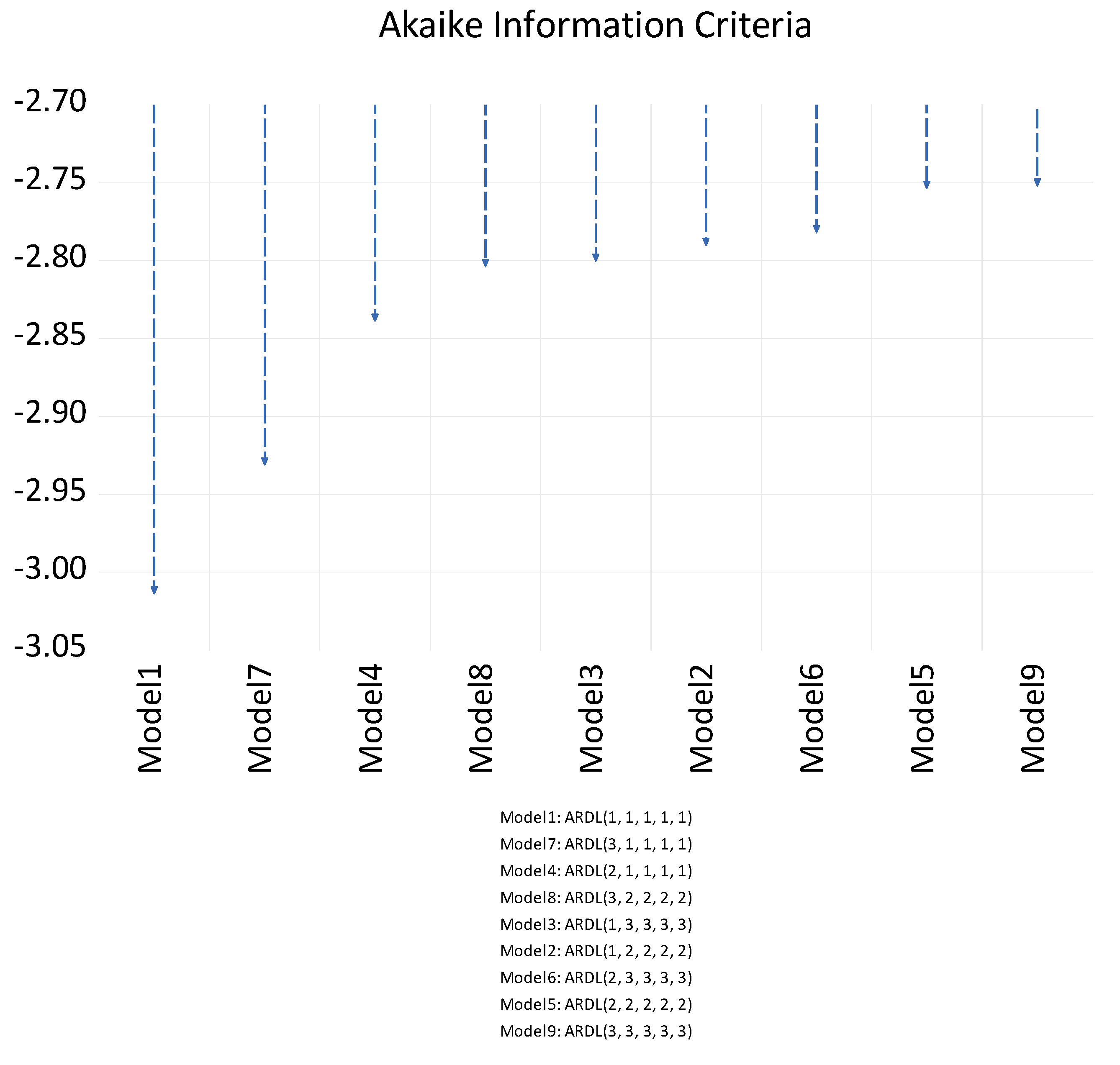
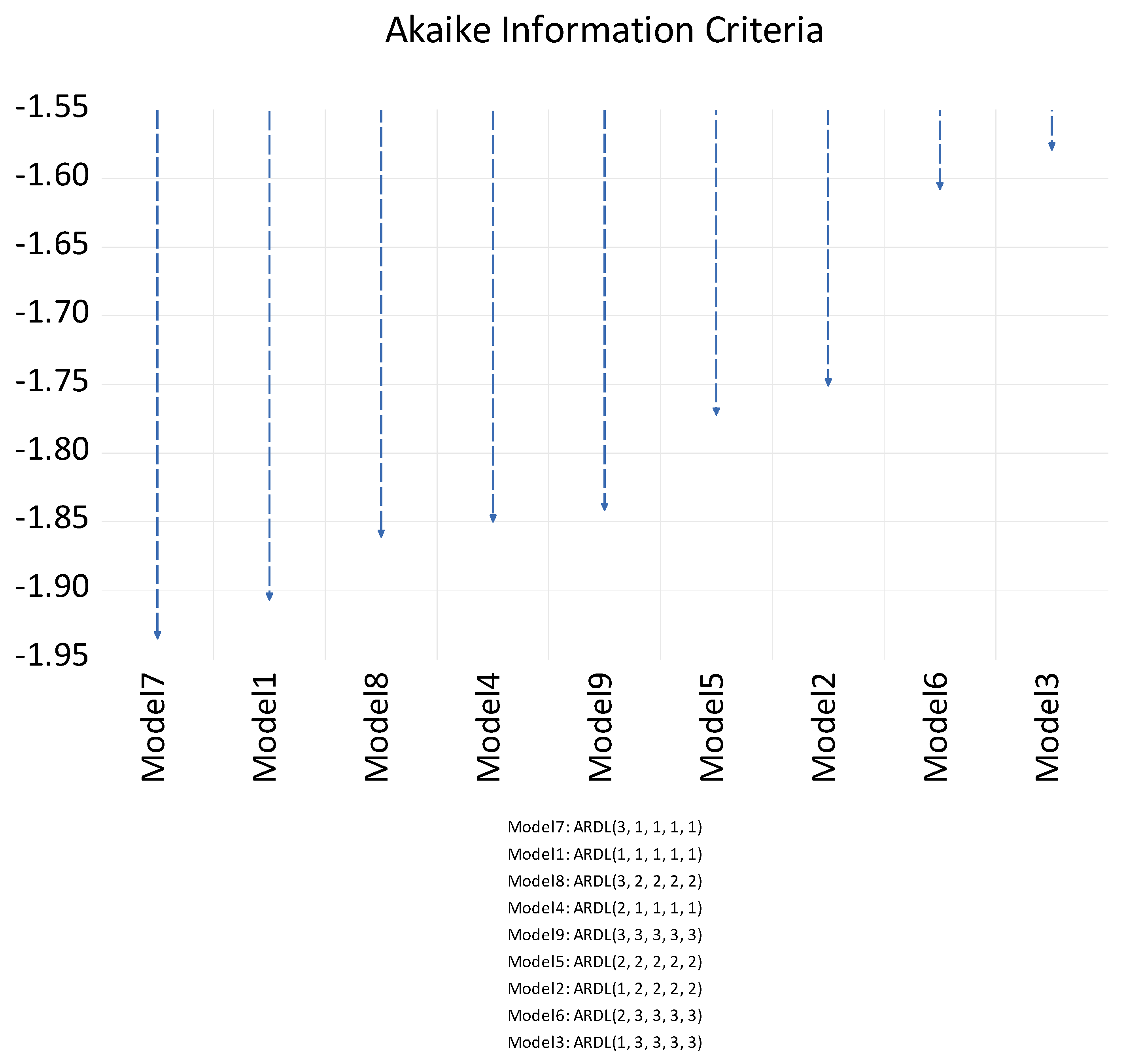
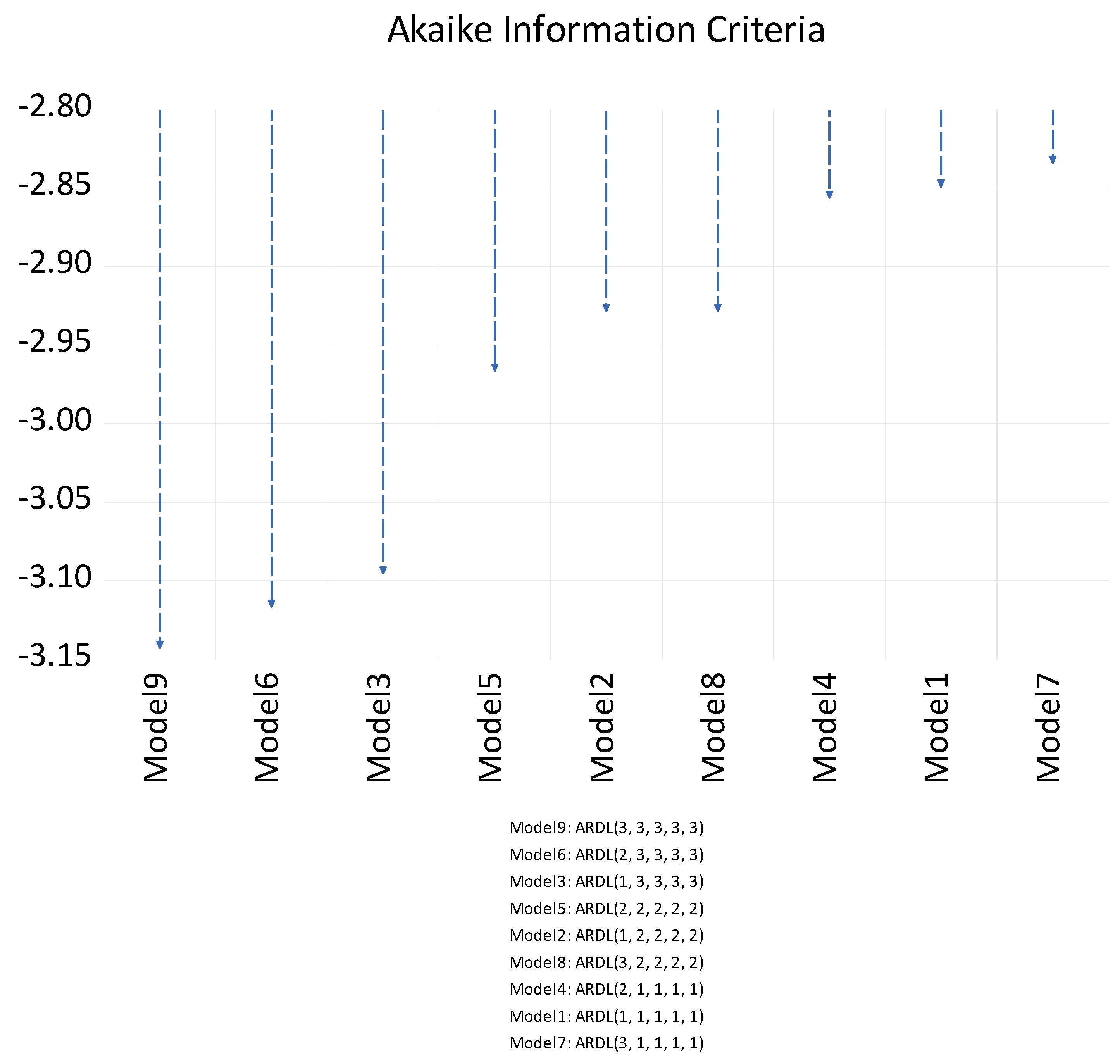
References
- Shahnazi, R.; Dehghan Shabani, Z. The Effects of Renewable Energy, Spatial Spillover of CO2 Emissions and Economic Freedom on CO2 Emissions in the EU. Renew. Energy 2021, 169, 293–307. [Google Scholar] [CrossRef]
- Sharif, A.; Kartal, M.T.; Bekun, F.V.; Pata, U.K.; Foon, C.L.; Kılıç Depren, S. Role of Green Technology, Environmental Taxes, and Green Energy towards Sustainable Environment: Insights from Sovereign Nordic Countries by CS-ARDL Approach. Gondwana Res. 2023, 117, 194–206. [Google Scholar] [CrossRef]
- Dritsaki, M.; Dritsaki, C. Trade Openness and Economic Growth: A Panel Data Analysis of Baltic Countries. Asian Econ. Financ. Rev. 2020, 10, 313–324. [Google Scholar] [CrossRef]
- Kar, A.K. Environmental Kuznets Curve for CO2 Emissions in Baltic Countries: An Empirical Investigation. Environ. Sci. Pollut. Res. 2022, 29, 47189–47208. [Google Scholar] [CrossRef]
- Grodzicki, T.; Jankiewicz, M. The Impact of Renewable Energy and Urbanization on CO2 Emissions in Europe—Spatio-Temporal Approach. Environ. Dev. 2022, 44, 100755. [Google Scholar] [CrossRef]
- Breyer, C.; Bogdanov, D.; Ram, M.; Khalili, S.; Vartiainen, E.; Moser, D.; Román Medina, E.; Masson, G.; Aghahosseini, A.; Mensah, T.N.O.; et al. Reflecting the Energy Transition from a European Perspective and in the Global Context—Relevance of Solar Photovoltaics Benchmarking Two Ambitious Scenarios. Prog. Photovoltaics Res. Appl. 2023, 31, 1369–1395. [Google Scholar] [CrossRef]
- Budžytė, A.; Balžekienė, A. Public Perceptions of Institutional Responsibility in Climate Change Risk in Baltic Nordic Countries. J. Secur. Sustain. Issues 2018, 7, 675–684. [Google Scholar] [CrossRef]
- Laktuka, K.; Pakere, I.; Kalnbalkite, A.; Zlaugotne, B.; Blumberga, D. Renewable Energy Project Implementation: Will the Baltic States Catch up with the Nordic Countries? Util. Policy 2023, 82, 101577. [Google Scholar] [CrossRef]
- Eyuboglu, K.; Uzar, U. A New Perspective to Environmental Degradation: The Linkages between Higher Education and CO2 Emissions. Environ. Sci. Pollut. Res. 2021, 28, 482–493. [Google Scholar] [CrossRef]
- Alkhateeb, T.T.Y.; Mahmood, H.; Altamimi, N.N.; Furqan, M. Role of Education and Economic Growth on the CO2 Emissions in Saudi Arabia. Entrep. Sustain. Issues 2020, 8, 195–209. [Google Scholar] [CrossRef]
- Liu, N.; Hong, C.; Sohail, M.T. Does Financial Inclusion and Education Limit CO2 Emissions in China? A New Perspective. Environ. Sci. Pollut. Res. 2022, 29, 18452–18459. [Google Scholar] [CrossRef] [PubMed]
- Xin, Y.; Yang, S.; Rasheed, M.F. Exploring the Impacts of Education and Unemployment on CO2 Emissions. Econ. Res. Istraživanja 2023, 36, 2110139. [Google Scholar] [CrossRef]
- Ping, S.; Shah, S.A.A. Green Finance, Renewable Energy, Financial Development, FDI, and CO2 Nexus under the Impact of Higher Education. Environ. Sci. Pollut. Res. 2023, 30, 33524–33541. [Google Scholar] [CrossRef] [PubMed]
- Zhu, Y.; Zafar, S.M.; Salahodjaev, R. Mitigations Pathways towards Sustainable Development: Assessing the Influence of Higher Education on Environmental Quality in BRICS Economies. Environ. Sci. Pollut. Res. 2022, 29, 86851–86858. [Google Scholar] [CrossRef]
- Li, X.; Ullah, S. Caring for the Environment: How CO2 Emissions Respond to Human Capital in BRICS Economies? Environ. Sci. Pollut. Res. 2022, 29, 18036–18046. [Google Scholar] [CrossRef]
- Xu, P.; Zhang, J.; Mehmood, U. How Do Green Investments, Foreign Direct Investment, and Renewable Energy Impact CO2 Emissions? Measuring the Role of Education in E-7 Nations. Sustainability 2023, 15, 14052. [Google Scholar] [CrossRef]
- Irfan, M.; Chen, Z.; Adebayo, T.S.; Al-Faryan, M.A.S. Socio-Economic and Technological Drivers of Sustainability and Resources Management: Demonstrating the Role of Information and Communications Technology and Financial Development Using Advanced Wavelet Coherence Approach. Resour. Policy 2022, 79, 103038. [Google Scholar] [CrossRef]
- Zafar, M.W.; Saleem, M.M.; Destek, M.A.; Caglar, A.E. The Dynamic Linkage between Remittances, Export Diversification, Education, Renewable Energy Consumption, Economic Growth, and CO2 Emissions in Top Remittance-Receiving Countries. Sustain. Dev. 2022, 30, 165–175. [Google Scholar] [CrossRef]
- Li, H.; Khattak, S.I.; Ahmad, M. Measuring the Impact of Higher Education on Environmental Pollution: New Evidence from Thirty Provinces in China. Environ. Ecol. Stat. 2021, 28, 187–217. [Google Scholar] [CrossRef]
- Mehmood, U. Contribution of Renewable Energy towards Environmental Quality: The Role of Education to Achieve Sustainable Development Goals in G11 Countries. Renew. Energy 2021, 178, 600–607. [Google Scholar] [CrossRef]
- Umaroh, R. Does Education Reduce CO2 Emmisions? Empirical Evidence of The Environmental Kuznets Curve in Indonesia. J. Rev. Glob. Econ. 2019, 8, 662–671. [Google Scholar] [CrossRef]
- Liu, H.; Alharthi, M.; Atil, A.; Zafar, M.W.; Khan, I. A Non-Linear Analysis of the Impacts of Natural Resources and Education on Environmental Quality: Green Energy and Its Role in the Future. Resour. Policy 2022, 79, 102940. [Google Scholar] [CrossRef]
- Li, L.; Li, G.; Ozturk, I.; Ullah, S. Green Innovation and Environmental Sustainability: Do Clean Energy Investment and Education Matter? Energy Environ. 2023, 34, 2705–2720. [Google Scholar] [CrossRef]
- Xu, L.; Ullah, S. Evaluating the Impacts of Digitalization, Financial Efficiency, and Education on Renewable Energy Consumption: New Evidence from China. Environ. Sci. Pollut. Res. 2023, 30, 53538–53547. [Google Scholar] [CrossRef]
- Breusch, T.S.; Pagan, A.R. The Lagrange Multiplier Test and Its Applications to Model Specification in Econometrics. Rev. Econ. Stud. 1980, 47, 239. [Google Scholar] [CrossRef]
- Pesaran, M.H. General Diagnostic Tests for Cross Section Dependence in Panels General Diagnostic Tests for Cross Section Dependence in Panels; University of Cambridge: Cambridge, UK, 2004. [Google Scholar]
- Im, K.S.; Pesaran, M.H.; Shin, Y. Testing for Unit Roots in Heterogeneous Panels. J. Econom. 2003, 115, 53–74. [Google Scholar] [CrossRef]
- Maddala, G.S.; Wu, S. A Comparative Study of Unit Root Tests with Panel Data and a New Simple Test. Oxf. Bull. Econ. Stat. 1999, 61, 631–652. [Google Scholar] [CrossRef]
- Levin, A.; Lin, C.-F.; James Chu, C.-S. Unit Root Tests in Panel Data: Asymptotic and Finite-Sample Properties. J. Econom. 2002, 108, 1–24. [Google Scholar] [CrossRef]
- Pesaran, M.H. A Simple Panel Unit Root Test in the Presence of Cross-Section Dependence. J. Appl. Econom. 2007, 22, 265–312. [Google Scholar] [CrossRef]
- Dickey, D.A.; Fuller, W.A. Distribution of the Estimators for Autoregressive Time Series With a Unit Root. J. Am. Stat. Assoc. 1979, 74, 427. [Google Scholar] [CrossRef]
- Choi, I. Unit Root Tests for Panel Data. J. Int. Money Financ. 2001, 20, 249–272. [Google Scholar] [CrossRef]
- Pesaran, M.H.; Shin, Y. Cointegration and Speed of Convergence to Equilibrium. J. Econom. 1996, 71, 117–143. [Google Scholar] [CrossRef]
- O’Neill, B.C.; Jiang, L.; KC, S.; Fuchs, R.; Pachauri, S.; Laidlaw, E.K.; Zhang, T.; Zhou, W.; Ren, X. The Effect of Education on Determinants of Climate Change Risks. Nat. Sustain. 2020, 3, 520–528. [Google Scholar] [CrossRef]
- Tiba, S.; Belaid, F. Modeling the Nexus Between Sustainable Development and Renewable Energy: The African Perspectives. J. Econ. Surv. 2021, 35, 307–329. [Google Scholar] [CrossRef]
- Zouine, M.; EL Adnani, M.J.; Salhi, S.E. Higher Education’s Impact on CO2 Mitigation: MENA Insights with Consideration for Unemployment, Economic Growth, and Globalization. Front. Environ. Sci. 2024, 12, 1325598. [Google Scholar] [CrossRef]
- Georgescu, I.; Kinnunen, J. The Role of Foreign Direct Investments, Urbanization, Productivity, and Energy Consumption in Finland’s Carbon Emissions: An ARDL Approach. Environ. Sci. Pollut. Res. 2023, 30, 87685–87694. [Google Scholar] [CrossRef]
- Granger, C.W.J. Investigating Causal Relations by Econometric Models and Cross-Spectral Methods. Econometrica 1969, 37, 424. [Google Scholar] [CrossRef]
- Cui, Y.; Wei, Z.; Xue, Q.; Sohail, S. Educational Attainment and Environmental Kuznets Curve in China: An Aggregate and Disaggregate Analysis. Environ. Sci. Pollut. Res. 2022, 29, 45612–45622. [Google Scholar] [CrossRef]
- Balaguer, J.; Cantavella, M. The Role of Education in the Environmental Kuznets Curve. Evidence from Australian Data. Energy Econ. 2018, 70, 289–296. [Google Scholar] [CrossRef]
- Lee, H.; Park, C.; Jung, H. The Role of Tertiary Education on CO2 Emissions: Evidence from 151 Countries. Environ. Dev. Sustain. 2024, 26, 32081–32103. [Google Scholar] [CrossRef]
- Wang, W.-Z.; Liu, L.-C.; Liao, H.; Wei, Y.-M. Impacts of Urbanization on Carbon Emissions: An Empirical Analysis from OECD Countries. Energy Policy 2021, 151, 112171. [Google Scholar] [CrossRef]
- Chen, F.; Liu, A.; Lu, X.; Zhe, R.; Tong, J.; Akram, R. Evaluation of the Effects of Urbanization on Carbon Emissions: The Transformative Role of Government Effectiveness. Front. Energy Res. 2022, 10, 848800. [Google Scholar] [CrossRef]
- Cao, Z.; Meng, Q.; Gao, B. The Consumption Patterns and Determining Factors of Rural Household Energy: A Case Study of Henan Province in China. Renew. Sustain. Energy Rev. 2021, 146, 111142. [Google Scholar] [CrossRef]
- Pradhan, R.P.; Arvin, M.B.; Nair, M. Urbanization, Transportation Infrastructure, ICT, and Economic Growth: A Temporal Causal Analysis. Cities 2021, 115, 103213. [Google Scholar] [CrossRef]

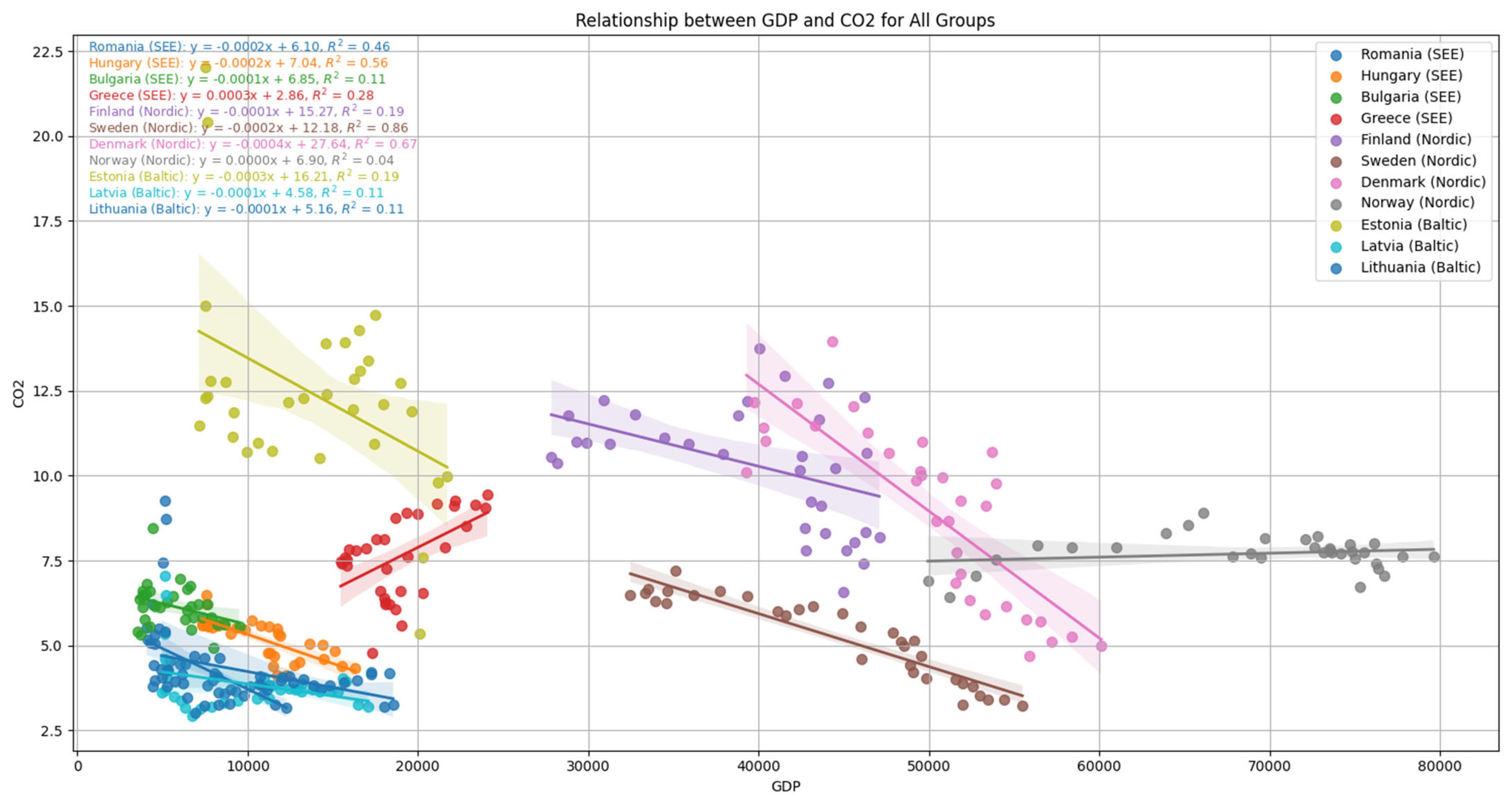
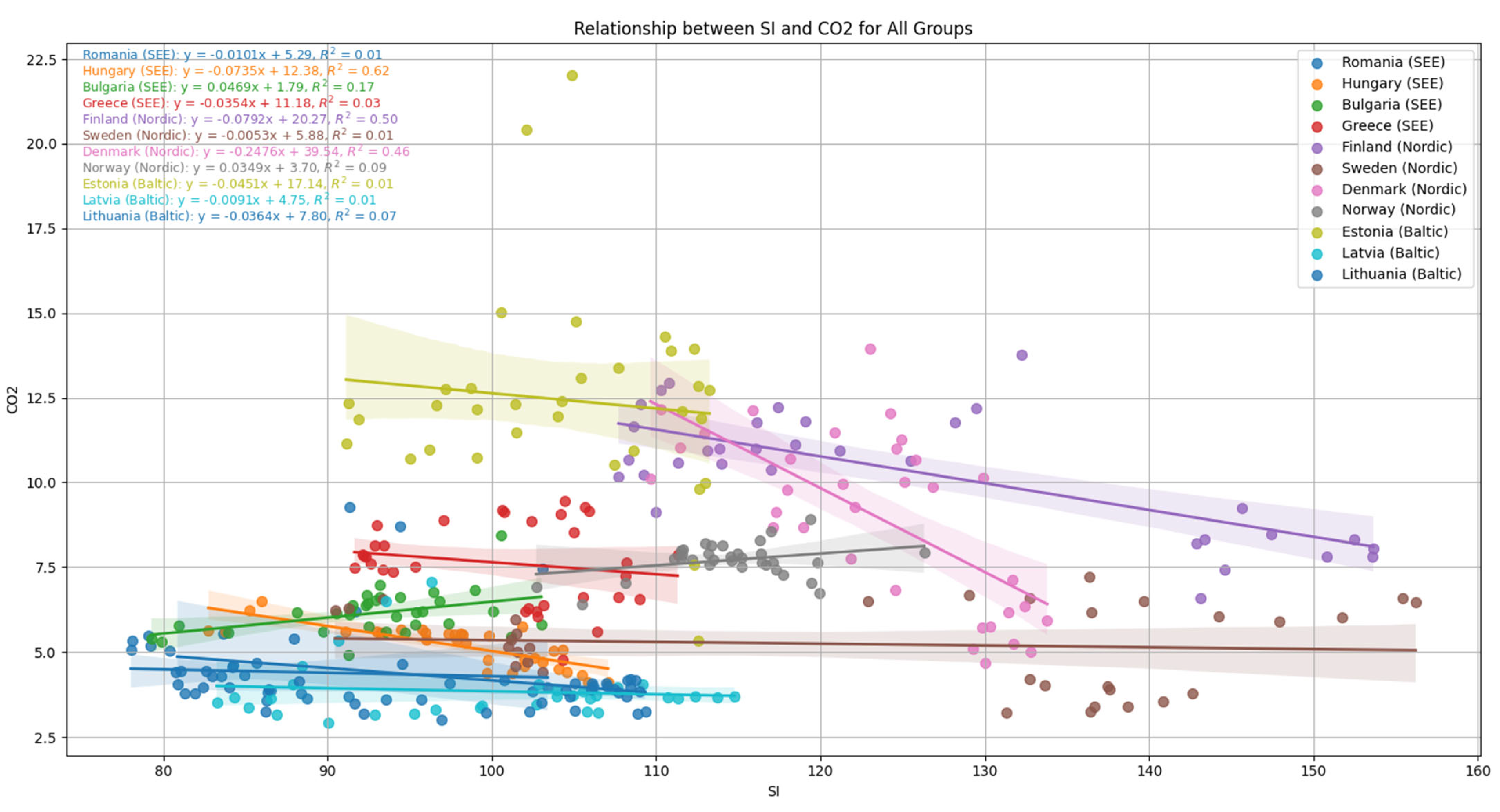
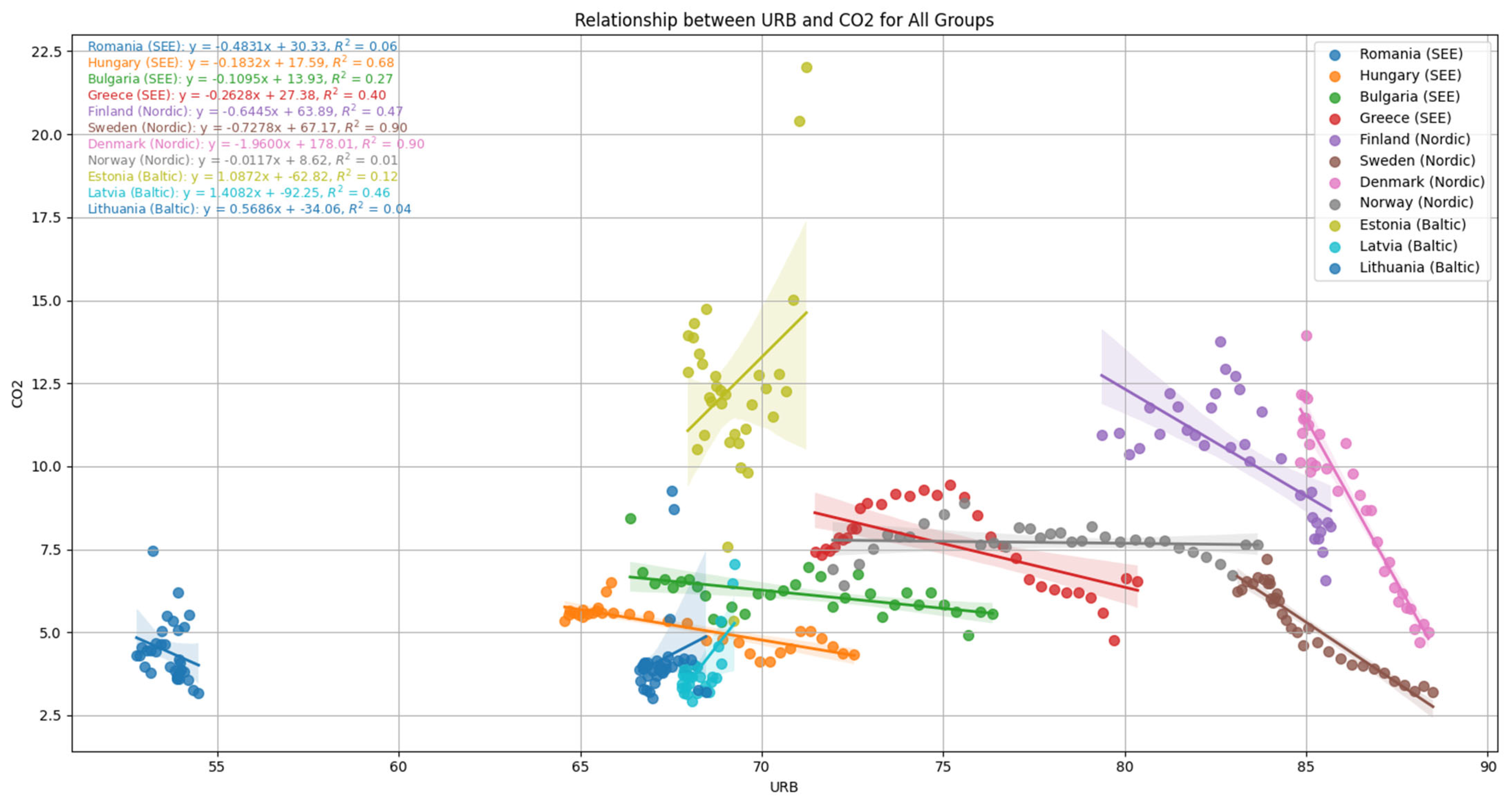
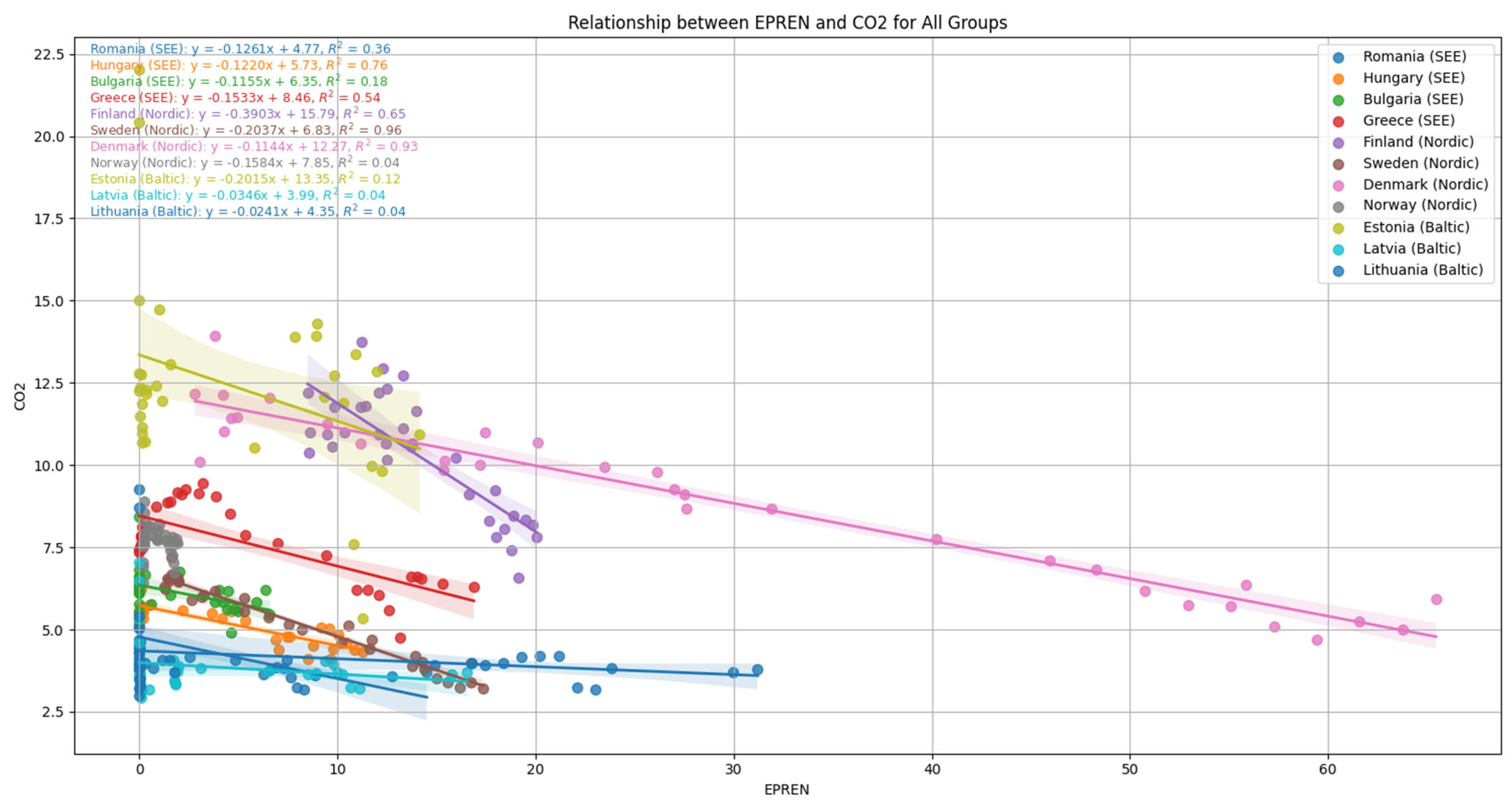
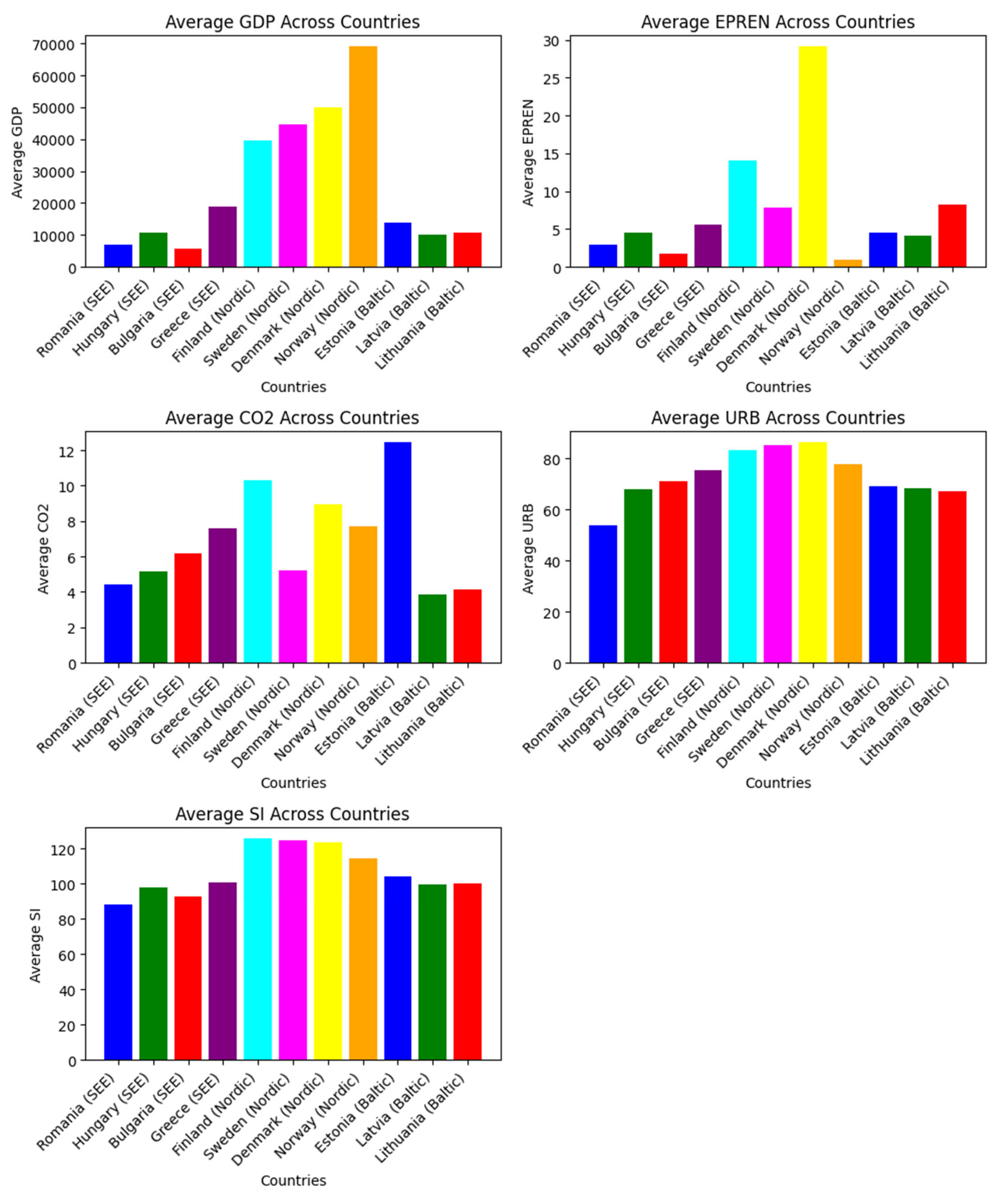

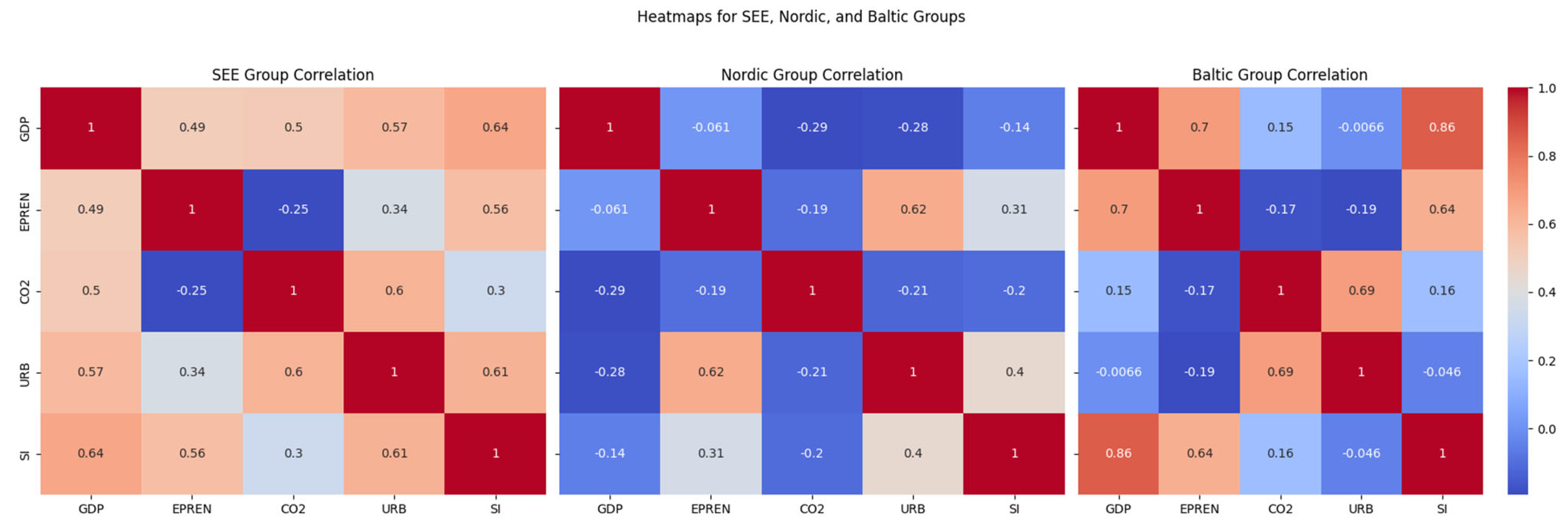
| Tests | Statistic | p-Value |
|---|---|---|
| Breusch–Pagan LM | 32.24 | 0.000 *** |
| Pesaran-scaled LM | 7.57 | 0.000 *** |
| Pesaran CD | 2.51 | 0.011 ** |
| Tests | Statistic | p-Value |
|---|---|---|
| Breusch–Pagan LM | 85.55 | 0.000 *** |
| Pesaran-scaled LM | 22.96 | 0.000 *** |
| Pesaran CD | 8.14 | 0.000 *** |
| Tests | Statistic | p-Value |
|---|---|---|
| Breusch–Pagan LM | 52.71 | 0.000 *** |
| Pesaran-scaled LM | 20.29 | 0.000 *** |
| Pesaran CD | 7.23 | 0.000 *** |
| At Levels | |||||
|---|---|---|---|---|---|
| CO2 | GDP | EPREN | SI | URB | |
| Unit root (Common Unit Root Process) | |||||
| LLC | −0.52 (0.300) | 1.41 (0.921) | −1.84 (0.032) ** | −0.73 (0.232) | 1.25 (0.895) |
| Unit root (Individual Unit Root Process) | |||||
| IPS | −0.45 (0.323) | 2.86 (0.997) | 0.25 (0.599) | −0.62 (0.266) | 2.30 (0.989) |
| ADF-Fisher Chi-square | 8.79 (0.360) | 1.88 (0.984) | 9.00 (0.341) | 8.88 (0.352) | 2.69 (0.952) |
| At first difference | |||||
| Unit root (Common Unit Root Process) | |||||
| LLC | −6.20 (0.000) *** | −3.80 (0.000) *** | −4.99 (0.000) *** | −2.09 (0.017) ** | −1.39 (0.081) * |
| Unit root (Individual Unit Root Process) | |||||
| IPS | 6.12 (0.000) *** | −3.73 (0.000) *** | −5.32 (0.000) *** | −5.04 (0.000) *** | −1.98 (0.023) ** |
| ADF-Fisher Chi-square | 50.52 (0.000) *** | 29.63 (0.000) *** | 43.02 (0.000) *** | 40.08 (0.000) *** | 16.65 (0.033) ** |
| At Levels | |||||
|---|---|---|---|---|---|
| CO2 | GDP | EPREN | SI | URB | |
| Unit root (Common Unit Root Process) | |||||
| LLC | −2.09 (0.017) ** | −0.86 (0.193) | −0.22 (0.410) | −0.35 (0.362) | −0.88 (0.188) |
| Unit root (Individual Unit Root Process) | |||||
| IPS | −5.04 (0.000) *** | 1.29 (0.901) | 0.32 (0.626) | 0.86 (0.806) | −0.38 (0.350) |
| ADF-Fisher Chi-square | 40.08 (0.000) *** | 1.39 (0.966) | 3.69 (0.717) | 2.57 (0.860) | 7.31 (0.292) |
| At first difference | |||||
| Unit root (Common Unit Root Process) | |||||
| LLC | −6.89 (0.000) *** | −5.54 (0.000) *** | −2.46 (0.006) *** | −1.52 (0.063) * | −2.06 (0.019) ** |
| Unit root (Individual Unit Root Process) | |||||
| IPS | −7.00 (0.000) *** | −4.69 (0.000) *** | −4.29 (0.000) *** | −3.39 (0.000) *** | −3.33 (0.000) *** |
| ADF-Fisher Chi-square | 51.18 (0.000) *** | 32.37 (0.000) *** | 29.39 (0.000) *** | 23.08 (0.000) *** | 22.34 (0.001) *** |
| At Levels | |||||
|---|---|---|---|---|---|
| CO2 | GDP | EPREN | SI | URB | |
| Unit root (Common Unit Root Process) | |||||
| LLC | −2.36 (0.008) *** | −0.29 (0.423) | 1.10 (0.866) | −0.85 (0.195) | −0.68 (0.248) |
| Unit root (Individual Unit Root Process) | |||||
| IPS | −1.84 (0.032) ** | 1.33 (0.908) | 0.75 (0.775) | −1.15 (0.123) | −2.36 (0.009) *** |
| ADF-Fisher Chi-square | 14.73 (0.064) * | 2.75 (0.948) | 8.49 (0.386) | 12.67 (0.123) | 21.34 (0.006) *** |
| At first difference | |||||
| Unit root (Common Unit Root Process) | |||||
| LLC | −7.93 (0.000) *** | −3.60 (0.000) *** | −11.10 (0.000) *** | −4.35 (0.000) *** | −1.61 (0.052) * |
| Unit root (Individual Unit Root Process) | |||||
| IPS | −10.10 (0.000) *** | −4.63 (0.000) *** | −11.63 (0.000) *** | −4.91 (0.000) *** | −2.08 (0.018) ** |
| ADF-Fisher Chi-square | 80.86 (0.000) *** | 33.72 (0.000) *** | 95.23 (0.000) *** | 38.76 (0.000) *** | 17.67 (0.023) ** |
| At Levels | |||||
|---|---|---|---|---|---|
| CO2 | GDP | EPREN | SI | URB | |
| CIPS | −2.04 (>0.10) | −1.88 (>0.10) | −1.32 (>0.10) | −2.91 (<0.01) | −0.51 (>0.10) |
| At first difference | |||||
| CIPS | −5.31 (<0.01) | −3.92 (<0.01) | −3.05 (<0.01) | −4.41 (<0.01) | −4.93 (<0.01) |
| At Levels | |||||
|---|---|---|---|---|---|
| CO2 | GDP | EPREN | SI | URB | |
| CIPS | −1.99 (>0.10) | −2.31 (<0.10) | −0.80 (>0.10) | −3.58 (<0.01) | −1.1 (>0.10) |
| At first difference | |||||
| CIPS | −6.43 (<0.01) | −8.74 (<0.01) | −3.50 (<0.01) | −5.36 (<0.01) | −4.43 (<0.01) |
| At Levels | |||||
|---|---|---|---|---|---|
| CO2 | GDP | EPREN | SI | URB | |
| CIPS | −1.88 (>0.10) | −2.19 (>0.10) | −2.61 (<0.01) | −2.11 (>0.10) | −2.06 (>0.10) |
| At first difference | |||||
| CIPS | −6.52 (<0.01) | −2.95 (<0.01) | −5.80 (<0.01) | −4.63 (<0.01) | −1.86 (<0.05) |
| Indicator | Coefficient | Std. Error | t-Statistic | Prob. * |
|---|---|---|---|---|
| Long-Run Equation | ||||
| GDP | 0.46 | 0.07 | 6.71 | 0.000 *** |
| EPREN | −0.001 | 0.008 | −0.17 | 0.862 |
| SI | 0.54 | 0.17 | 3.12 | 0.002 *** |
| URB | −4.54 | 0.51 | −8.79 | 0.000 *** |
| Short-Run Equation | ||||
| COINTEQ01 | −0.44 | 0.22 | −1.98 | 0.050 ** |
| D(GDP) | 0.67 | 0.14 | 4.64 | 0.000 *** |
| D(EPREN) | 0.009 | 0.004 | 2.09 | 0.038 ** |
| D(SI) | −0.18 | 0.07 | −2.36 | 0.020 ** |
| D(URB) | 2.38 | 5.05 | 0.47 | 0.638 |
| C | 6.48 | 3.33 | 1.94 | 0.054 * |
| Indicator | Coefficient | Std. Error | t-Statistic | Prob. * |
|---|---|---|---|---|
| Long-Run Equation | ||||
| GDP | 1.65 | 0.56 | 2.95 | 0.004 *** |
| EPREN | −0.03 | 0.01 | −1.93 | 0.056 * |
| SI | −6.22 | 1.88 | −3.29 | 0.001 *** |
| URB | −29.27 | 8.33 | −3.51 | 0.000 *** |
| Short-Run Equation | ||||
| COINTEQ01 | −0.27 | 0.16 | −1.70 | 0.092 * |
| D(CO2(-1)) | −0.04 | 0.08 | −0.59 | 0.590 |
| D(CO2(-2)) | −0.17 | 0.25 | −0.68 | 0.494 |
| D(GDP) | 0.02 | 0.40 | 0.04 | 0.950 |
| D(EPREN) | −0.01 | 0.008 | −2.08 | 0.840 |
| D(SI) | 0.59 | 0.48 | 1.23 | 0.219 |
| D(URB) | −8.78 | 10.19 | −0.86 | 0.391 |
| C | 38.59 | 22.58 | 1.70 | 0.091 * |
| Indicator | Coefficient | Std. Error | t-Statistic | Prob. * |
|---|---|---|---|---|
| Long-Run Equation | ||||
| GDP | −0.59 | 0.11 | −5.06 | 0.000 *** |
| EPREN | −0.14 | 0.04 | −3.19 | 0.002 *** |
| SI | −0.002 | 0.02 | −0.04 | 0.926 |
| URB | −18.02 | 1.42 | −12.65 | 0.000 *** |
| Short-Run Equation | ||||
| COINTEQ01 | −0.67 | 0.39 | −1.69 | 0.095 * |
| D(CO2(-1)) | −0.03 | 0.16 | −0.23 | 0.814 |
| D(CO2(-2)) | −0.17 | 0.30 | −0.57 | 0.565 |
| D(GDP) | 1.47 | 0.32 | 4.49 | 0.000 *** |
| D(GDP(-1)) | −0.50 | 0.66 | −0.76 | 0.448 |
| D(GDP(-2)) | 0.32 | 0.20 | 1.60 | 0.114 |
| D(EPREN) | −0.12 | 0.13 | −0.97 | 0.331 |
| D(EPREN(-1)) | −0.05 | 0.03 | −1.39 | 0.167 |
| D(EPREN(-2)) | −0.22 | 0.10 | −2.17 | 0.033 ** |
| D(SI) | −0.12 | 0.18 | −0.68 | 0.496 |
| D(SI(-1)) | −0.09 | 0.15 | −0.61 | 0.540 |
| D(SI(-2)) | −0.10 | 0.33 | −0.32 | 0.749 |
| D(URB) | −20.49 | 16.45 | −1.24 | 0.217 |
| D(URB(-1)) | 51.02 | 17.20 | 2.96 | 0.004 *** |
| D(URB(-2)) | −20.04 | 10.84 | −1.84 | 0.069 * |
| C | 59.19 | 34.94 | 1.69 | 0.095 * |
| Null Hypothesis (H0) | W-Stat. | Zbar-Stat. | Prob. | Conclusion |
|---|---|---|---|---|
| CO2 d.n.h.c EPREN | 0.43091 | −1.47385 | 0.1405 | |
| EPREN d.n.h.c CO2 | 5.16424 | 2.54526 | 0.0109 ** | EPREN→CO2 |
| GDP d.n.h.c EPREN | 6.12359 | 3.35985 | 0.0008 *** | GDP→EPREN |
| EPREN d.n.h.c GDP | 0.80766 | −1.15394 | 0.2485 | |
| URB d.n.h.c EPREN | 12.6326 | 8.88674 | 0 *** | URB→EPREN |
| EPREN d.n.h.c URB | 10.4557 | 7.0383 | 2.00 × 10−12 *** | EPREN→URB |
| SI d.n.h.c EPREN | 5.60675 | 2.921 | 0.0035 *** | SI→EPREN |
| EPREN d.n.h.c SI | 5.89473 | 3.16553 | 0.0015 *** | EPREN→SI |
| GDP d.n.h.c CO2 | 3.74383 | 1.33918 | 0.1805 | |
| CO2 d.n.h.c GDP | 5.46715 | 2.80247 | 0.0051 *** | CO2→GDP |
| URB d.n.h.c CO2 | 5.35484 | 2.7071 | 0.0068 *** | URB→CO2 |
| CO2 d.n.h.c URB | 7.79154 | 4.77612 | 2.00 × 10−6 *** | CO2→URB |
| SI d.n.h.c CO2 | 2.40077 | 0.19878 | 0.8424 | |
| CO2 d.n.h.c SI | 2.47469 | 0.26154 | 0.7937 | |
| URB d.n.h.c GDP | 4.47947 | 1.96382 | 0.0496 ** | URB→GDP |
| GDP d.n.h.c URB | 22.1 | 16.9256 | 0 *** | GDP→URB |
| SI d.n.h.c GDP | 3.95499 | 1.51848 | 0.1289 | |
| GDP d.n.h.c SI | 4.07379 | 1.61935 | 0.1054 | |
| SI d.n.h.c URB | 7.99255 | 4.9468 | 8.00 × 10−7 *** | SI→URB |
| URB d.n.h.c SI | 2.70994 | 0.4613 | 0.6446 |
| Null Hypothesis (H0) | W-Stat. | Zbar-Stat. | Prob. | Conclusion |
|---|---|---|---|---|
| EPREN d.n.h.c CO2 | 2.14182 | −0.01827 | 0.9854 | |
| CO2 d.n.h.c EPREN | 2.12324 | −0.03193 | 0.9745 | |
| GDP d.n.h.c CO2 | 1.9811 | −0.13646 | 0.8915 | |
| CO2 d.n.h.c GDP | 4.33831 | 1.59692 | 0.1103 | |
| SI d.n.h.c CO2 | 2.98871 | 0.60449 | 0.5455 | |
| CO2 d.n.h.c SI | 8.6893 | 4.79641 | 2.00 × 10−6 *** | CO2→SI |
| URB d.n.h.c CO2 | 3.90243 | 1.27639 | 0.2018 | |
| CO2 d.n.h.c URB | 1.48908 | −0.49826 | 0.6183 | |
| GDP d.n.h.c EPREN | 5.02459 | 2.10157 | 0.0356 ** | GDP→EPREN |
| EPREN d.n.h.c GDP | 1.98644 | −0.13253 | 0.8946 | |
| SI d.n.h.c EPREN | 4.31539 | 1.58006 | 0.1141 | |
| EPREN d.n.h.c SI | 6.6527 | 3.2988 | 0.001 *** | EPREN→SI |
| URB d.n.h.c EPREN | 3.89412 | 1.27028 | 0.204 | |
| EPREN d.n.h.c URB | 6.04593 | 2.85261 | 0.0043 *** | EPREN→URB |
| SI d.n.h.c GDP | 1.69077 | −0.34995 | 0.7264 | |
| GDP d.n.h.c SI | 6.60746 | 3.26553 | 0.0011 *** | GDP→SI |
| URB d.n.h.c GDP | 3.25985 | 0.80387 | 0.4215 | |
| GDP d.n.h.c URB | 5.48288 | 2.43857 | 0.0147 ** | GDP→URB |
| URB d.n.h.c SI | 7.87495 | 4.19758 | 3.00 × 10−5 *** | URB→SI |
| SI d.n.h.c URB | 3.17029 | 0.73801 | 0.4605 |
| Null Hypothesis: | W-Stat. | Zbar-Stat. | Prob. | Conclusion |
|---|---|---|---|---|
| EPREN d.n.h.c CO2 | 4.81934 | 2.2524 | 0.0243 ** | EPREN→ CO2 |
| CO2 d.n.h.c EPREN | 2.25633 | 0.07613 | 0.9393 | |
| GDP d.n.h.c CO2 | 5.94837 | 3.21108 | 0.0013 *** | GDP→ CO2 |
| CO2 d.n.h.c GDP | 1.83682 | −0.28007 | 0.7794 | |
| SI d.n.h.c CO2 | 0.94086 | −1.04085 | 0.2979 | |
| CO2 d.n.h.c SI | 4.29696 | 1.80885 | 0.0705 * | CO2 →SI |
| URB d.n.h.c CO2 | 6.52605 | 3.70158 | 0.0002 *** | URB→ CO2 |
| CO2 d.n.h.c URB | 4.28009 | 1.79453 | 0.0727* | CO2→URB |
| GDP d.n.h.c EPREN | 3.95164 | 1.51563 | 0.1296 | |
| EPREN d.n.h.c GDP | 2.15258 | −0.01196 | 0.9905 | |
| SI d.n.h.c EPREN | 1.09059 | −0.91371 | 0.3609 | |
| EPREN d.n.h.c SI | 1.79916 | −0.31205 | 0.755 | |
| URB d.n.h.c EPREN | 8.03086 | 4.97933 | 6.00 × 10−7 *** | URB→EPREN |
| EPREN d.n.h.c URB | 5.99548 | 3.25107 | 0.0011 *** | EPREN→URB |
| SI d.n.h.c GDP | 3.86935 | 1.44576 | 0.1482 | |
| GDP d.n.h.c SI | 1.174 | −0.84288 | 0.3993 | |
| URB d.n.h.c GDP | 2.59914 | 0.36722 | 0.7135 | |
| GDP d.n.h.c URB | 3.60064 | 1.2176 | 0.2234 | |
| URB d.n.h.c SI | 6.32875 | 3.53405 | 0.0004 *** | URB→SI |
| SI d.n.h.c URB | 6.74043 | 3.88362 | 0.0001 *** | SI→URB |
| Variable | SEE | Baltic | Nordic |
|---|---|---|---|
| GDP | +0.46 *** | +1.65 *** | −0.59 *** |
| EPREN | ns | −0.03 * | −0.14 *** |
| SI | +0.54 *** | −6.22 *** | ns |
| URB | −4.54 *** | −29.27 *** | −18.02 *** |
| ECT | −0.44 ** | −0.27 * | −0.67 * |
Disclaimer/Publisher’s Note: The statements, opinions and data contained in all publications are solely those of the individual author(s) and contributor(s) and not of MDPI and/or the editor(s). MDPI and/or the editor(s) disclaim responsibility for any injury to people or property resulting from any ideas, methods, instructions or products referred to in the content. |
© 2025 by the authors. Licensee MDPI, Basel, Switzerland. This article is an open access article distributed under the terms and conditions of the Creative Commons Attribution (CC BY) license (https://creativecommons.org/licenses/by/4.0/).
Share and Cite
Bâra, A.; Georgescu, I.A.; Oprea, S.-V. Does Education Make a Difference in Combating Climate Change? Analyzing Its Impact on CO2 Emissions in the South-East European, Nordic, and Baltic Regions. Sustainability 2025, 17, 4789. https://doi.org/10.3390/su17114789
Bâra A, Georgescu IA, Oprea S-V. Does Education Make a Difference in Combating Climate Change? Analyzing Its Impact on CO2 Emissions in the South-East European, Nordic, and Baltic Regions. Sustainability. 2025; 17(11):4789. https://doi.org/10.3390/su17114789
Chicago/Turabian StyleBâra, Adela, Irina Alexandra Georgescu, and Simona-Vasilica Oprea. 2025. "Does Education Make a Difference in Combating Climate Change? Analyzing Its Impact on CO2 Emissions in the South-East European, Nordic, and Baltic Regions" Sustainability 17, no. 11: 4789. https://doi.org/10.3390/su17114789
APA StyleBâra, A., Georgescu, I. A., & Oprea, S.-V. (2025). Does Education Make a Difference in Combating Climate Change? Analyzing Its Impact on CO2 Emissions in the South-East European, Nordic, and Baltic Regions. Sustainability, 17(11), 4789. https://doi.org/10.3390/su17114789








